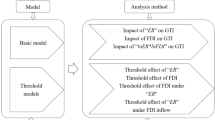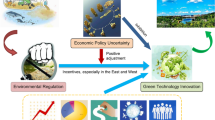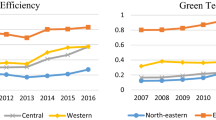Abstract
To further clarify the relationship between environmental regulation and green technology innovation and discuss how environmental regulation affects green technology innovation through import trade, this paper analyzes the impacts of environmental regulation and import trade on green technology innovation and the transmission effect of import trade based on panel data for 30 provinces in China for 2008 to 2017. The results show that (1) environmental regulation first plays a role in promoting green technology innovation and then restrains it, and import trade can significantly promote green technology innovation; (2) under the constraints of stronger environmental regulations, import trade has a significantly positive effect on green technology innovation; and (3) environmental regulation can further enhance the technology spillover effects of import trade in regions with high absorptive capacity and regions with high levels of R&D investment. This paper analyzes the impact of environmental regulation on green technology innovation from the perspective of import trade and makes up for the deficiencies of existing research. It also lays a foundation for scholars to study the relationship between environmental regulation and green technology innovation in the midst of heterogeneous government regulation capabilities and industries in the future.
Similar content being viewed by others
Availability of data and materials
Not applicable.
Notes
Data from the 2007–2018 China Environment Statistical Yearbook.
Data source: analysis on the development of China’s environmental protection industry in 2017.
References
Ahmed K (2020) Environmental policy stringency, related technological change and emissions inventory in 20 OECD countries. J Environ Manag 274(22):111209. https://doi.org/10.1016/j.jenvman.2020.111209
Altıntaş H, Kassouri Y (2020) The impact of energy technology innovations on cleaner energy supply and carbon footprints in Europe: a linear versus nonlinear approach. J Clean Prod 276(46):124140. https://doi.org/10.1016/j.jclepro.2020.124140
Bartel AP, Ichniowski C, Shaw KL (2007) How does information technology really affect productivity? Plant-level comparisons of product innovation, process improvement and worker skills. Q J Econ 122(4):1721–1758
Bashir M, Khan S (2019) Effect of bilateral FDI, energy consumption, CO2 emission and capital on economic growth of Asia countries. Energy Rep 5(11):1305–1315
Borsatto J, Amui L (2019) Green innovation: unfolding the relation with environmental regulations and competitiveness. Resour Conserv Recycl 149(10):445–454
Bu M, Wagner M (2016) Racing to the bottom and racing to the top: the crucial role of firm characteristics in foreign direct investment choices. J Int Bus Stud 47(9):1032–1057
Bugamelli M, Schivardi F, Zizza R (2010) The euro and firm restructuring. CEPR Discussion Pap (10).
Cai X, Zhu B, Zhang H, Li L, Xie M (2020) Can direct environmental regulation promote green technology innovation in heavily polluting industries? Evidence from Chinese listed companies. Sci Total Environ 746(34):140810. https://doi.org/10.1016/j.scitotenv.2020.140810
Chakraborty P, Chatterjee C (2017) Does environmental regulation indirectly induce upstream innovation? New evidence from India. Res Policy 46(5):939–955
Chen Z, Zhang J, Zheng W (2017) Import and innovation: evidence from Chinese firms. Eur Econ Rev 94:205–220
Coe DT, Helpman E (1995) International R&D spillovers. Eur Econ Rev 39:859–887
Damijan JP, Kostevc C (2015) Learning from trade through innovation: causal link between imports, exports and innovation in Spanish microdata. Oxf Bull Econ Stat 77(3):408–436
Dauda L, Long X, Mensah CN, Salman M, Boamah KB, Ampon-Wireko S, Dogbe CSK (2021) Innovation, trade openness and CO2 emissions in selected countries in Africa. J Clean Prod 281(4):125143. https://doi.org/10.1016/j.jclepro.2020.125143
Dechezleprêtre A, Sato M (2017) The impacts of environmental regulations on competitiveness. Rev Environ Econ Policy 11(2):183–206
Dixit AK, Stiglitz JE (1997) Monopolistic competition and optimum product diversity. Am Econ Rev 6(3):297–308
Du W, Li M (2020) Influence of environmental regulation on promoting the low-carbon transformation of China’s foreign trade: based on the dual margin of export enterprise. J Clean Prod 244(3):118687. https://doi.org/10.1016/j.jclepro.2019.118687
Feng S, Sui B, Liu H, Li G (2020) Environmental decentralization and innovation in China. Econ Model, In press. https://doi.org/10.1016/j.econmod.2020.02.048
Freeman RB, Kleiner MM (2005) The last American shoe manufacturers: decreasing productivity and increasing profits in the shift from piece rates to continuous flow production. Ind Relat: A Journal of Economy and Society 44(2):307–330
Fu T, Cai C, Jian Z (2020) The illusion of “win–win” solution: why environmental regulation in china promotes firm performance? Struct Chang Econ Dyn 52(3):366–373
Ganda F (2019) The impact of innovation and technology investments on carbon emissions in selected organisation for economic co-operation and development countries. J Clean Prod 217(12):469–483
Gereffi HJ, Sturgeon T (2005) The governance of global value chains. Rev Int Polit Econ 12(1):78–104
Goldberg PA, Khandelwal A, Pavcnik N (2009) Trade liberalization and new imported inputs. Am Econ Rev 99(2):494–500
Goldberg PK, Khandelwal AK, Pavcnik N (2010) Imported intermediate inputs and domestic product growth: evidence from India. Q J Econ 125(4):1727–1767
Gray WB, Shadbegian RJ (2003) Plant vintage, technology, and environmental regulation [J]. J Environ Econ Manag 46(3):384–402
Greenstone M, List JA, Syverson C (2012) The effects of environmental regulation on the competitiveness of U.S. manufacturing. Soc Sci Electron Publ 93(2):431–435
Grossman GM, Helpman E (1991) Trade, knowledge spillovers, and growth. Eur Econ Rev 35(3):517–526
Halpern L, Koren M, Szeidl A (2015) Imported inputs and productivity. Am Econ Rev 105(12):3660–3703
Hojnik J, Ruzzier M (2016) The driving forces of process eco-innovation and its impact on performance: insights from Slovenia. J Clean Prod 133(28):812–825
Hu J, Pan X, Huang Q (2020) Quantity or quality? The impacts of environmental regulation on firms’ innovation–quasi-natural experiment based on China’s carbon emissions trading pilot. Technol Forecast Soc Chang 158(9):120122. https://doi.org/10.1016/j.techfore.2020.120122
Humphrey J, Schmitz H (2002) How does insertion in global value chains affect upgrading in industrial clusters? Reg Stud 36(9):1017–1027
Jaffe AB, Palmer KL (1997) Environmental regulation and innovation: a panel data study. Rev Econ Stat 79(4):610–619
Kesidou E, Wu L (2020) Stringency of environmental regulation and eco-innovation: evidence from the eleventh Five-Year Plan and green patents. Econ Lett 190(5):109090. https://doi.org/10.1016/j.econlet.2020.109090
Lanjouw JO, Mody S (1996) Innovation and the international diffusion of environmentally responsive technology. Res Policy 25(4):549–571
Lanoie P, Patry M, Lajeunesse R (2008) Environmental regulation and productivity: testing the porter hypothesis. J Prod Anal 30(2):121–128
Li G, Guo F, Di D (2021) Regional competition, environmental decentralization, and target selection of local governments. Sci Total Environ 755(5):142536. https://doi.org/10.1016/j.scitotenv.2020.142536
Liu Q, Qiu L (2016) Intermediate input imports and innovations: evidence from Chinese firm’s patent filings. J Int Econ 103:166–183
Lu Y, Ng T (2012) Do imports spur incremental innovation in the South. China Econ Rev 23(4):819–832
Luo L, Liang S (2016) Green technology innovation efficiency and factor decomposition of regional industrial enterprises in China. Chin J Popul Resourc Environ 26(09):149–157
Luo Y, Salman M, Lu Z (2021) Heterogeneous impacts of environmental regulations and foreign direct investment on green innovation across different regions in China. Sci Total Environ 759(8):143744. https://doi.org/10.1016/j.scitotenv.2020.143744
Neves SA, Marques AC, Patrício M (2020) Determinants of CO2 emissions in European Union countries: does environmental regulation reduce environmental pollution? Econ Anal Policy 68(4):114–125
Peng X (2020) Strategic interaction of environmental regulation and green productivity growth in China: green innovation or pollution refuge. Sci Total Environ 732(24):139200. https://doi.org/10.1016/j.scitotenv.2020.139200
Peuckert J (2014) What shapes the impact of environmental regulation on competitiveness? Evidence from Executive Opinion Surveys. Environ Innov Soc Transit 10:77–94
Porter ME (1991) America’s green strategy. Entific Am 264(4):193–246
Rubashkina Y, Galeotti M, Verdolini E (2015) Environmental regulation and competitiveness: empirical evidence on the Porter Hypothesis from European manufacturing sectors. Energy Policy 83(8):288–300
Schmitz H (2004) Local upgrading in global chains: recent findings. Paper to Be Presented at the DRUID Summer Conference.
Silva GM, Gomes PJ, Lages LF (2019) Does importer involvement contribute to product innovation? The role of export market factors and intra-firm coordination. Ind Mark Manag 78(4):169–182
Song M, Wang S, Zhang H (2020) Could environmental regulation and R&D tax incentives affect green product innovation? J Clean Prod 258(17):120849. https://doi.org/10.1016/j.jclepro.2020.120849
Sun H, Pofoura AK, Mensah IA, Li L, Mohsin M (2020) The role of environmental entrepreneurship for sustainable development: evidence from 35 countries in Sub-Saharan Africa. Sci Total Environ 741(34):140132. https://doi.org/10.1016/j.scitotenv.2020.140132
Wang Y, Shen N (2016) Environmental regulation and environmental productivity: the case of China. Renew Sustain Energy Rev 62:758–766
Wang X, Zhang C, Zhang Z (2019) Pollution haven or porter? The impact of environmental regulation on location choices of pollution-intensive firms in China. J Environ Manag 248(20):109248. https://doi.org/10.1016/j.jenvman.2019.07.019
Wei J, Zhang H, Liu S, Zhang H (2019) Technological innovation, environmental regulation, and green total factor efficiency of industrial water resources. J Clean Prod 211:61–69
Wu H, Li Y, Hao Y, Ren S, Zhang P (2020a) Environmental decentralization, local government competition, and regional green development: evidence from China. Sci Total Environ 708(8):135085. https://doi.org/10.1016/j.scitotenv.2019.135085
Wu H, Hao Y, Ren S (2020b) How do environmental regulation and environmental decentralization affect green total factor energy efficiency: evidence from China. Energy Econ 91(9):104880. https://doi.org/10.1016/j.eneco.2020.104880
Xiao L, Xie D (2016) Introduction of foreign technology and local innovation growth: complementary or alternative -- based on the perspective of heterogeneous absorptive capacity. Chin Ind Econ 9:75–92
Xu S (2009) Empirical analysis of the impact of technological progress on energy efficiency. Sci Res Manag 30(06):16–24
Yang G, Zha D, Wang X, Chen Q (2020) Exploring the nonlinear association between environmental regulation and carbon intensity in China: the mediating effect of green technology. Ecol Indic 114(7):106309. https://doi.org/10.1016/j.ecolind.2020.106309
Yasmeen H, Tan Q, Zameer H, Tan J, Nawaz K (2020) Exploring the impact of technological innovation, environmental regulations and urbanization on ecological efficiency of China in the context of COP21. J Environ Manag 274(22):111210. https://doi.org/10.1016/j.jenvman.2020.111210
You D, Zhang Y, Yuan B (2019) Environmental regulation and firm eco-innovation: evidence of moderating effects of fiscal decentralization and political competition from listed Chinese industrial companies. J Clean Prod 207(2):1072–1083
Yu W, Ramanathan R, Nath P (2017) Environmental pressures and performance: an analysis of the roles of environmental innovation strategy and marketing capability. Technol Forecast Soc Chang 117(4):160–169
Zhang W, Li G (2020) Environmental decentralization, environmental protection investment, and green technology innovation. Environ Sci Pollut Res. https://doi.org/10.1007/s11356-020-09849-z
Zhang J, Kang L, Li H, Ballesteros-Pérez P, Skitmore M, Zuo J (2020a) The impact of environmental regulations on urban green innovation efficiency: the case of Xi’an. Sustain Cities Soc 57(6):102123. https://doi.org/10.1016/j.scs.2020.102123
Zhang W, Li G, Uddin MK, Guo S (2020b) Environmental regulation, foreign investment behavior, and carbon emissions for 30 provinces in China. J Clean Prod 248(7):119208
Zhou Q, Song Y, Wan N, Zhang X (2020) Non-linear effects of environmental regulation and innovation – spatial interaction evidence from the Yangtze River Delta in China. Environ Sci Pol 114(12):263–274. https://doi.org/10.1016/j.jclepro.2019.119208
Author information
Authors and Affiliations
Contributions
LS and SF carried out the model analyses and contributed to the writing of the paper. DT contributed to the collection of data and reviewed the literature. WZ reviewed the literature.
Corresponding author
Ethics declarations
Consent to participate
The authors have read and approved the final manuscript.
Consent for publication
The authors agree to the publication of the journal.
Conflict of interest
The authors declare no competing interests.
Additional information
Responsible Editor: Eyup Dogan
Publisher’s note
Springer Nature remains neutral with regard to jurisdictional claims in published maps and institutional affiliations.
Highlights
Green technology innovation is essential to reducing the pollution emissions of enterprises.
Environmental regulation first plays a role in promoting green technology innovation and then restrains it.
Under constraints of stronger environmental regulation, import trade has a significantly positive effect on green technology innovation.
Environmental regulation can further enhance the technology spillover effect of import trade in high absorptive capacity regions and high R&D investment regions
Rights and permissions
About this article
Cite this article
Shang, L., Tan, D., Feng, S. et al. Environmental regulation, import trade, and green technology innovation. Environ Sci Pollut Res 29, 12864–12874 (2022). https://doi.org/10.1007/s11356-021-13490-9
Received:
Accepted:
Published:
Issue Date:
DOI: https://doi.org/10.1007/s11356-021-13490-9




